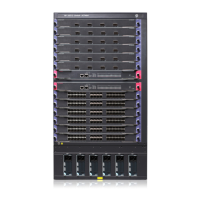260
Ste
Command
Remarks
5. Enter address family view.
• ipv4-family vpnv4
• l2vpn-family
• vpls-family
Use one of the commands as
needed.
For information about BGP-L2VPN
address family and VPLS address
family, see MPLS Command
Reference.
6. Allow the local AS number to
appear in the AS_PATH
attribute of a received route
and set the maximum number
of repetitions.
peer { group-name | ip-address }
allow-as-loop [ number ]
Optional.
7. Enable a peer or peer group
for an address family and
enable the exchange of BGP
routing information of the
address family.
peer { group-name | ip-address }
enable
By default, only IPv4 routing
information is exchanged between
BGP peers.
8. Add a peer into an existing
peer group.
peer ip-address group group-name
Optional.
9. Configure the system to use
the local address as the next
hop of a route to be
advertised to a specified peer
or peer group.
peer { group-name | ip-address }
next-hop-local
Optional.
By default, the system uses the local
address as the next hop of a route
to be advertised to an EBGP peer.
NOTE:
In the inter-AS option C solution,
configure the peer
{
group-name
|
ip-address
}
next-hop-invariable
command on the RR for multi-hop
EBGP neighbors and reflector
clients to make sure the next hop of
a VPN route is not changed.
10. Configure the system to be the
RR and set a peer or peer
group as the client of the RR.
peer { group-name | ip-address }
reflect-client
Optional.
By default, no RR or RR client is
configured.
11. Enable the Outbound Route
Filtering (ORF) capability for a
BGP peer or peer group.
peer { group-name | ip-address }
capability-advertise orf ip-prefix
{ both | receive | send }
Optional.
By default, the ORF capability is
disabled on a BGP peer or peer
group.
12. Enable route target filtering
for received VPNv4 routes.
policy vpn-target
Optional.
Enabled by default.
13. Enable route reflection
between clients.
reflect between-clients
Optional.
Enabled by default.
14. Specify the cluster ID of the
RR.
reflector cluster-id { cluster-id |
ip-address }
Optional.
Router ID of an RR in the cluster by
default.

